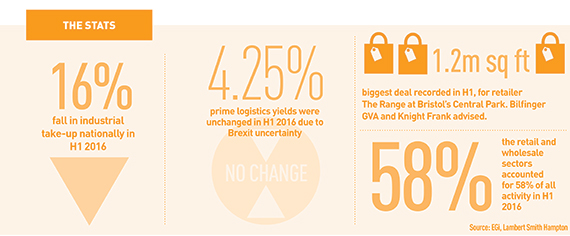The industry is facing a critical supply bottleneck. What can it and other organisations do to alleviate the problem?

Simplistically, we can consider the speculative development process as a three-piece jigsaw puzzle and look at who holds the pieces.
Since last June, we have seen reduced occupier demand, but not a significant reduction, and there are signs, based on current enquiries, that occupier demand remains strong.
So the occupier holds the first piece.
The reduction in the number of speculative schemes is directly related to investor confidence and fund managers’ inability to commit investor funds to that level of risk at this time.
Investors therefore hold the second jigsaw piece.
Landowners hold the third. Whether they be developers with a land bank or corporate entities with surplus land worried about their duty to shareholders and selling into an uncertain market.
My message to corporate landowners is that there is no doubt among developers that the prevailing occupier demand is sustainable, that investor confidence will return, and that during this time, we should continue to buy land and prepare it ready for plot development.
Our appetite for land remains healthy. While investors remain cautious, this will not immediately alleviate the supply bottleneck, but it will mean good-quality land with the necessary planning permission will be available when fund managers are free to invest in speculative development again. We can use this time to reduce the lead-in time by investing now in ground works, infrastructure and planning.
Each key stakeholder is influenced by the planning process and we need a continued and sufficient supply of allocated employment land. There is a conflict between the UK’s employment and residential land needs and we need to strike a balance for our long-term economic growth. I’m not convinced we’ve got that balance right. As applicants try to anticipate the needs of occupiers and of their institutional landlords, they need to be given every reasonable opportunity to secure flexible consents that are fit for purpose.
Developer landowners only hold one piece of the jigsaw so we need to ensure that we manage it properly, ready for the return of the investor.
Gareth Williams, development director, St Francis Group

The industrial sector makes an increasingly important contribution to the UK’s economic competitiveness and growth.
The availability of land at sufficient scale in locations with good transport links and affordable labour is critical. As a sector, we work very closely with landowners who are typically private owners, corporates and local councils. The UK industrial market is seeing a supply bottleneck due in part to the cycle of local plans that authorities are preparing with their new visions for growth, housing, infrastructure and employment. The duty to co-operate with neighbouring authorities can limit the local government’s flexibility and commitment to bring sites forward and supply the market in a timely manner, often missing the property market cycles.
The best local authorities are those that encourage a greater degree of interaction with our sector, to listen to our needs and those of the tenants who are ultimately going to occupy this industrial space. Developers in return need to consistently respond in an informed, constructive and transparent way. We are seeing this happening with some of the leading local authorities and it is realising benefits for all involved.
Land for the industrial and logistics sector also needs to be integrated into local plans, and developers need to share their development plans for that land to help local authorities plan and implement job creation, infrastructure and economic growth objectives.
We have seen this approach work very well in central Bedfordshire where the local authority took a proactive approach to supporting development at our Luton scheme on Junction 11A of the M1.
John Duggan, chairman, Baytree Logistics Properties
In the news
Heathrow take-off welcomed
An end to uncertainty over airports policy was welcomed, following the government’s decision to support a third runway at Heathrow. The Chartered Institute of Logistics and Transport’s chairman, Paul Le Blond, said: “Logistics and transport operators should use the opportunities that this decision will bring to plan long-term investments.”
Underground asset
A 2m sq ft underground warehouse that could serve Heathrow is being proposed by Formal Investments, sitting beneath the 110-acre Rectory Farm park project, near Cranford.
Corby park presses on
Frogmore and Mulberry Developments acquired 300 acres near Corby, Northants, for a Midlands logistics park capable of containing 5m sq ft of facilities. NatWest backed the duo with £25m.
IDI sells European assets
IDI Gazeley has reportedly exited the Spanish and Italian industrial markets with the sale of 2.2m sq ft of logistics assets to Real Estate Funds, managed by Blackstone, for an undisclosed price.
Watch out for: EG industrial and logistics summit special
 Drones downer
Drones downer
Will drones take off as a delivery method? General consensus is that it is unlikely. Tom Woodham, director at PwC, said technology will help interaction with deliveries, rather than getting products from the sky.
E for everything
E-commerce will evolve much faster in the next five years and only retailers and tech companies that adapt will survive, according to panellist Andrew Smith, director at LondonMetric Property.
Flexible friends
Developers will need to become more flexible to net occupiers. “There is a lot more that developers could do for tenants,” said John Clements, director at Verdion. “It’s not a case of saying, ‘Here is a box, go and sort yourself out.’”
Bright future
A continued positive outlook is predicted for logistics investment, due to a demand and supply imbalance and robust occupational market. Despite economic and political uncertainty, the sector will continue to attract investment.












